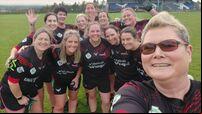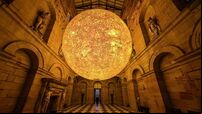‘When I got that first garden, it was like a drug...’

Mags Riordan of Bumblebee Flower Farm.
WHILE many people have been craving the company of others during nearly a year of successive lockdowns and restrictions, Drimoleague flower farmer Mags Riordan says she has all the company she needs: her bees.
“I’m in my own little world and I have great conversations with my bees and butterflies,” Mags says.
“They have a lot of character, you know. The different bees have different buzzing noises, and they’re quite gregarious. We view them as a threat, but they’re just investigating. A bumblebee will let you know when it feels threatened because it will lift its legs, and then you just back off. They’re very docile. I just adore them.”
But Mags’ four-acre farm in West Cork was not always buzzing with life: when she took up residence in 2003, it was a “big, blank field,” she says.
“It was scary how silent it was. There were no birds or anything.”
Now, the farm is alive with insects and bird life, due to Mags’ work as a flower grower: pollinators are attracted by the vast array of edible flowers she grows in nine polytunnels and 55 outdoor beds.
“There’s birds, bees, solitary bees, hoverflies, hedgehogs, hares, and rabbits,” she says.
“I respect and love my indigenous weeds, so there’s plenty for them all to eat.”
Mags was born in Cork city and moved west with her three young children in 1993. She had never done any gardening, not to mention farming. When the gardening bug bit because of her new-found rural space, she soon found herself noticing and caring deeply about nature’s complex cycles.
“When I got that first garden, it was like a drug,” she says.
“I just couldn’t stop. Then I started seeing how everything you did had another effect, that for every action there really is a reaction, everything is happening in these cycles.”

Having moved to her current location a decade later, she planted corridors of shrubs and trees to accommodate more wildlife, and did a course in horticulture. Eventually, she started growing her own flowers commercially.
“It’s been a journey of happy accidents,” Mags says.
“None of it was designed, but here I am today. I started growing my own flowers and in 2013, a bride approached me because she wanted a posy for her flower girl, who was two and who put everything in her mouth.
“That started my edible journey: I realised that over 60% of the flowers I was growing were edible, and they were organic too.”
Having trained as a florist, Mags had been horrified to learn about the ecological harms caused by the global cut flower industry.
“I got an awful rash on my hands and I couldn’t shift it, so I started investigating how imported flowers were produced and I thought, Jesus, I don’t want to be a part of that industry. It saddened me to think of all the awful things being done in the name of beauty.”
With her focus on edible flowers, grown organically, she wanted to grow as much as possible from seed she saved herself, and of course, pollinators including bees, butterflies and

are necessary to produce viable seed. Over time, she has built expertise in gardening practices that encourage and nourish the vital little creatures, and named her business Bumblebee Flower Farm in their honour.
Mags is nowhere near alone in her ion for pollinators, and ensuring their survival is no hobby; 90 of the most important food crops for humans require pollination, meaning that 35% of our diet is under threat due to declining insect life.
Pollinators include all species who fertilise plants by spreading pollen grains from the male part of a flower to the female part.
And there’s no doubt about it, that despite Ireland’s superficially ‘green’ image, our wild pollinators are facing drastic threats.
Some 30% of Irish bee species are facing extinction, according to the National Biodiversity Centre.
Six species are critically endangered, 10 are endangered and 14 are listed as vulnerable.
“My mission is to save humanity from extinction,” Mags says earnestly. “Some people laugh at that, but to me, it’s like a Jenga block. If we take that block out, everything else falls and there’s no going back.”
Like so many small Irish horticulture businesses that rely on connections to venues and to events such as weddings, Bumblebee Flower Farm was hit severely when the Covid-19 crisis came into being almost a year ago.
Yet Mags has managed to bounce back, even picking up a Solo Businesswoman of the Year award from Network West Cork for her business recovery.
“In March, it got to the stage where I was scared to open my emails because it was all cancellations,” she says. “I didn’t qualify for the Covid payment so I had to do something. My pride was out the window and I went on Twitter and said, lads, I don’t qualify for the Covid payment and I’m swimming in flowers, would ye like some.”
Mags had an enormous reaction to her social media call-out and she successfully sold the majority of her produce online.
“We have customers now who love what we do, who love the fact that they can get a beautiful bouquet whose prime objective has been to feed our pollinators,” she says.
Now, to give a little back, she has devised a able pollinator plan for home gardeners, so that people can grow and cut their own flowers, and she’s sharing tips and advice with a monthly Instagram Live.
“The plan gives you suggestions on where to place plants and when to sow,” she says. “It tells you the nectar and pollen ratings of plants, what’s edible and what isn’t.”
There’s a buyer-beware message here too; Mags says that many seed packets marketed to take advantage of the buzz around pollinators are not all they’re cracked up to be, either because the plants are non-native and did not evolve with Irish pollinators, or because of seeds being chemically treated.
“So much of what’s out there for sale is just a marketing ploy and is actually non-native and useless,” she says. “And there are certain places selling seeds incredibly cheap, but they’re actually toxic to pollinators because the seeds have been treated.
“I have a bit of an agenda with this, to bring people gently in the direction of respecting our wild flowers, because they are the stars. They have co-evolved with our insects. But if I told people to go out and plant dandelions and daisies, they wouldn’t do it.”
While gardeners may have summer blooms a-plenty, Mags wants to spread the word that ing pollinators is a year-round task that requires seasonal planning.
Here are five early and late flowering recommendations from the queen bee herself:
“This time of year, winter heather goes right through from November to March. With climate change, we have bumblebees that don’t overwinter, so they need food.”
“I know it’s not an indigenous plant, but it’s been here so long and it’s a winter-flowering plant. It’s there for the pollinators in winter, and then in March it gets berries, which feed the birds.”
“Berberis and Pittosporum flower at a similar time. They’re not the biggest, showiest flowers but they’re a great stop-gap until other flowers come in.”
“50 feet away from my cotoneaster hedge, I can hear the buzzing of bees. It’s alive; some people are afraid to walk under it because it’s so noisy.”
Hydrangeas
“In late autumn, some of the hydrangeas are great for hoverflies and you also have annuals that can go on quite late as well.”
Connect with Mags on Instagram at https://www.instagram.com/bumblebeefarm_/







 App?
App?


